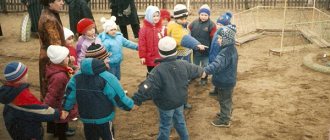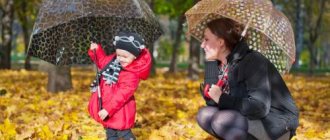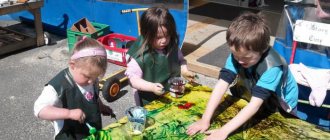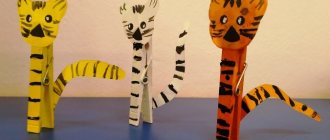"Information stand for parents"
Information stand for parents
Contents 1 Goals of creating a corner for parents 2 Form of presentation of material 3 Contents 4 Where to place 5 Requirements 6 Design example
Purposes of creating a corner for parents The stand or shelf, as well as tablets, which are located in the reception area and are intended to familiarize parents with the life of the group where their child is being raised, are called a corner for parents.
The goals of its creation are: Awakening family interest in the life of the group and the garden (materials on planned excursions, creative projects, etc.); Demonstration of the results of work on the training, development and upbringing of children (photos, photo collages, drawings by children, crafts, including those made with parents, etc.); Familiarity with regulatory documents relating to parenthood (information about the rights of the child, a list of rights and responsibilities of parents, the charter of a preschool institution, etc.)
Form of presentation of material In order for the corner to fulfill its purpose as much as possible, its design should be varied, but not redundant. Based on the methodological experience of generations of educators, we can conclude that for a beautiful and meaningful parent corner it is enough to choose one of the following positions: 1–2 stands; 3–4 tablets (the size is selected according to the dimensions of the corner); 1 table or shelf for the exhibition of children's works (they are conveniently placed in the mat); posters or images of silhouettes of toys, fairy-tale characters
Contents Children's drawings, bright pictures, photographs of children during activities and walks are only part of the design of a corner for parents, the content of which can be divided into two groups of materials: permanent and temporary.
The first include: annually updated age characteristics of children; a list of age-appropriate skills and abilities (rewritten every year); daily routine for the current academic year; menu; rules “Every parent should know this”; information about the program under which the preschool child care institution operates; telephone numbers of the teacher, assistant teacher, social service, ambulance, helpline; information from specialists (their names, office hours, phone numbers); tips for training fine motor skills, logic, memory, speaking; notes on disease prevention (organized, for example, in a folder); table with data on weighing and measuring the height of babies; letters of gratitude for parents (for helping the group, kindergarten, etc.)
Temporary materials require the following information: list of birthday people for the month; health sheet with information for a specific day; a list of activities for the whole week (with topics, tasks and a brief description of the content); information about the results of the children’s work (exhibition of works, results of psychological and pedagogical tests, etc.); a list of topics that need to be repeated with children (for example, learn a riddle, poem, proverb); a list of activities for a period of the academic period (usually a month); news from the life of kindergarten; information about upcoming competitions (for example, “Summer vacation for my family”, “Weekend with dad”, etc.)
It’s convenient when a place is allocated in the parent’s corner for a lost and found area for children’s lost things.
Where to place It is best if the corner is located near the window. Any well-lit area of the room will also work.
Methodists recommend placing stands not in the game room, but in the locker room and near the entrance.
In this case, the font color should be chosen brighter, and the size of the letters should be such that the text is readable even from a distance of a meter.
Requirements
As with all educational materials, there are several requirements for the parents' corner: the names of the sections are highlighted in bright, for example, red;
the text must be divided into paragraphs; availability of constant and updated information;
Regarding the issue of information content, the relevance of the information is important. And the task is not only to match the material to a given moment in the life of the group, such as a report on events, a work plan for the week or a menu, but to create a selection of useful recommendations for parents of a specific age group.
Design example
Materials:
- ceiling tiles;
- narrow plinth for the ceiling;
- cardboard (thick);
- colored self-adhesive;
- PVA glue;
- scissors and paper knife;
- colored paper;
- A4 plastic pockets
Instructions:
We cut out rectangles of the required size from the ceiling tiles (it all depends on the size of the corner, as well as on the dimensions of the train and the number of cars in it). Glue the blanks onto cardboard. Cover with self-adhesive tape. We place the ceiling plinth on the edges. It can also be used to imitate frames for sheets of information (instead of plastic pockets). Using a stapler or glue, we attach plastic pockets to the cars
6. From one tile we cut out a locomotive proportional to the trailers.
7. We cut out flowers from colored paper, which we use to tie the trailers together.
8.We print the information on A4 sheets and place it in pockets.
Thank you for your attention!
Consultation for parents on the topic of Spring
Consultation for parents on the topic: “Spring”
Winter is over. Severe frosts and snowstorms are behind us. The sun is getting warmer and stronger every day, the streets are becoming brighter and walking with the kids is a pleasure. Spring is the most useful and pleasant time of the year for walking with children. It is in the spring that the sun produces a lot of ultraviolet radiation, which is extremely necessary for a child's growing body. Walking in the fresh air is always an interesting and useful activity.
Spring walks are extremely beneficial from the point of view of the baby's early development. Walk with your child along the street, in the park, see what changes are taking place in nature: how the buds swell, the first leaves and grass emerge, what spring flowers exist. Watch birds build nests in the trees. You can even try building a birdhouse and hanging it next to your house. Observing nature is a very interesting and educational activity. It forms in children knowledge about nature, teaches them to observe and contemplate, and develops an aesthetic principle.
In the process of observation, children learn to distinguish shapes, sizes, colors, the nature of the surface and much more. When observing living beings (insects, birds, animals), children learn the nature of movement, sounds and various characteristics. During these observations, children develop qualities such as intelligence, observation, analytical abilities, the ability to compare and draw conclusions.
In spring, observing nature is much more interesting than in winter. While walking with your baby, tell him about spring: why the snow melts, where numerous streams come from, why the sun shines so brightly and why the sky is blue and not gray. Try to hear “spring” sounds with your child: the ringing of drops, the murmuring of streams, the singing of birds.
Tell your child what smells spring brings: melted snow, birch buds, first snowdrops and others. Tell your child what happens in the spring, after the snow melts, migratory birds return from southern countries, buds swell on the trees, the first grass emerges from under the snow, snowdrops bloom.
Show your child the willow, let him touch it, tell him that the willow is one of the first to bloom in the spring; bugs, flies, and butterflies flock to its smell. Let the baby pick a few branches and take them home, invite him to put the bouquet in a vase with water and watch how the branches change, how the first leaves appear on them.
Explain to your child why all these changes occur, introduce him to the concept of “season”. Talk about why it was necessary to dress warmly in winter, but in spring you can walk in lighter clothes.
Choose an object on the street for comparison and watch how it changes every day. For example, pay attention to the child on a spring walk that today there is still snow in the clearing, but tomorrow there will be just wet ground, in a few days you will be able to see the first grass, and then bright flowers.
With such communication, the child’s vocabulary expands and active speech develops.
Also, walking is a useful physical exercise that anyone can do, regardless of age. While walking, a person uses almost all the muscles of the body, the muscles of the arms, back, pelvis and legs work especially well. In addition, such walks are extremely important for the health of various body systems. And this is not all the benefits of such exercises in the fresh air.
Walking perfectly activates vital processes in the body. Be sure to involve your children in such activities. Add children's games to constant walks, as well as entertainment in recreation parks, and you will be surprised at how rarely your child starts to get sick.
Spring walks should not be canceled even if the weather is not sunny.
To begin with, you should simply take it for granted that whether you like it or not, the child will still climb into the deepest puddle and find thicker dirt. The baby wants to know everything, to experience first-hand what his mother warns about. Therefore, be patient and do not scold the baby. It’s so interesting how your reflection looks in a puddle, how the dirt sticks to your boots. How fun it is to splash the water with your hands and make Easter cakes from wet soil!
If you don't want your child to flop around aimlessly in the mud during a spring walk, show him that this can be done with benefit. Does your baby want to dig? Invite him to do this under trees, where the ground is at least slightly covered with leaves and grass. If a child is drawn to water like a magnet, then let him walk through the puddles, show how interesting it is to float boats or just blades of grass, sticks or leaves along streams. You can take radio-controlled toys with you on a walk. Spring is a great time to fly RC helicopters or airplanes.
Try not to forbid your child to experiment, because this can lead to isolation and indecisiveness in the child in the future. Let your little one make the right decision for himself, even if you end up bringing home a grimy baby. Let your child grow up healthy, active and happy!
What to do with a child on a walk in the spring?
1. “Count the birds.”
In spring, nature comes alive. And even if the leaves have not yet appeared, the birds have already begun to enjoy the warmth and smells that the spring air is rich in. With a child who can count, you can play the following game: who will notice more birds during a walk. You can finish the game as follows: feed the birds millet or special food.
2. “Steps of a Lilliputian.”
This game is good for several children or the whole family to play.
Choose a goal and mark a starting line. Let the players compete: who will cover the distance faster with Lilliputian steps (these are steps when a leg is placed close to the other leg during a step). "Giant Steps"
The meaning of the game is the same. However, now the child must spread his legs as wide as he can (adults may give in a little...).
3. “Letting in the sunbeams.”
If the weather is sunny, don't forget to take a mirror with you. The baby will be happy to make the day even sunny by letting the sun shine on houses and trees. Choose some distant target and practice who can launch the bunny that far.
4. “Let’s go swimming in the puddle.”
Make boats at home or on a walk, and then launch them in the nearest puddle.
5. “Let’s let the bubbles… go swimming!”
You can let not only boats sail through puddles, but also soap bubbles. They will last longer on the water and shimmer with all the colors. Watching such swimmers is a real pleasure.
6. “Looking for the first signs of spring.”
Arm yourself with a camera and go in search of spring. The first swollen buds, lively birds - all these are the first signs that spring is coming.
7. “Drawing on the asphalt.”
If the asphalt is dry, it's time to take out the crayons and draw an invitation to spring: sun, flowers and grass. Perhaps this will speed up the arrival of heat!
8. “Hunt for words and letters.”
If the child knows the letters, you can play a game where the child and the adult look around for objects that begin with the selected letter. You can choose different letters. For example, you are looking for words starting with the letter “a”, and the child is looking for words starting with the letter “m”. Who will find the most items?
9. “Developing speed and coordination.”
This game is very famous. The rules are simple: children stand between the two leaders, their goal is to knock the players out of the center with the ball. It is best to take an inflatable ball so as not to injure children. Take a larger ball, then the task for the kids will become much more difficult, and the risk of injury will decrease.
10. “Developing coordination.”
Participants stand opposite the leader. The game is very simple. All children must show movements opposite to those shown by the leader. For example, if the leader lowers his hands, the kids should raise them, if the leader crouches, the children should jump, etc. If the kid makes a mistake three times, he is eliminated. The winner is the one who can survive the longest.
11. “Developing balance.”
For this exercise, you need to place two children opposite each other at a distance of 2-3 child steps. At the signal, one, standing on one leg, with his palms outstretched, should hit the palms of the other baby. The essence of the game is to unbalance your opponent. The one who touches the ground first loses.
12. “Developing speed of movement.”
For this game you need a ball and chalk. On the asphalt, draw a circle with a diameter of about 2 meters and indicate the directions of movement. The child stands in the center and hits the ball on the ground, after which he runs away in the given direction. While the ball makes 3 hits, the baby must run. The one who runs farthest wins. This game is group, but can also be played alone.
13. “Developing jumping ability.”
This game requires several players; you should divide them into teams. A line is drawn on the ground with which the length of the jump will be measured. The landing site should be marked on the heels. You need to jump in the opposite direction from the marked place; another participant must do this. His main task is to jump over this result and jump further, thereby earning a point for his team. The team with the most points wins.
To strengthen knowledge about spring, you can also play games with children.
1. Association game
. You throw the ball to the child and say the word, and he throws the ball back to you and says the word (snow-stream, tree-bird, spring-sun).
2. Didactic game “When does this happen?”:
• The snowball is melting, the meadow has come to life. The day is coming. When does this happen? (in March, spring)
• Snow on the fields, ice on the rivers. The blizzard is walking, when does this happen? (Winter)
• A swallow has flown in,
She let down her feathers.
The sun warms gently,
What time is this? (Spring)
• The sun is shining, the linden tree is blooming. When does rye ripen? (In summer)
• The streams rang,
The rooks have arrived.
The bee brought the first honey to the hive.
Who's to say, who knows
When does this happen? (Spring)
3. Game “Say kindly.”
For example, the sun is the sun, a puddle is a puddle.
There are a lot of games and activities that can be invented for a child’s development. The presented games are suitable for activities with a child, both on the street during a walk and at home.
Spring
- a wonderful time of year loved by children. The main thing is to find something to interest the child, something to watch. And of course, be patient and let the children experiment outside. Such walks will bring a lot of positive emotions to you and your children.



